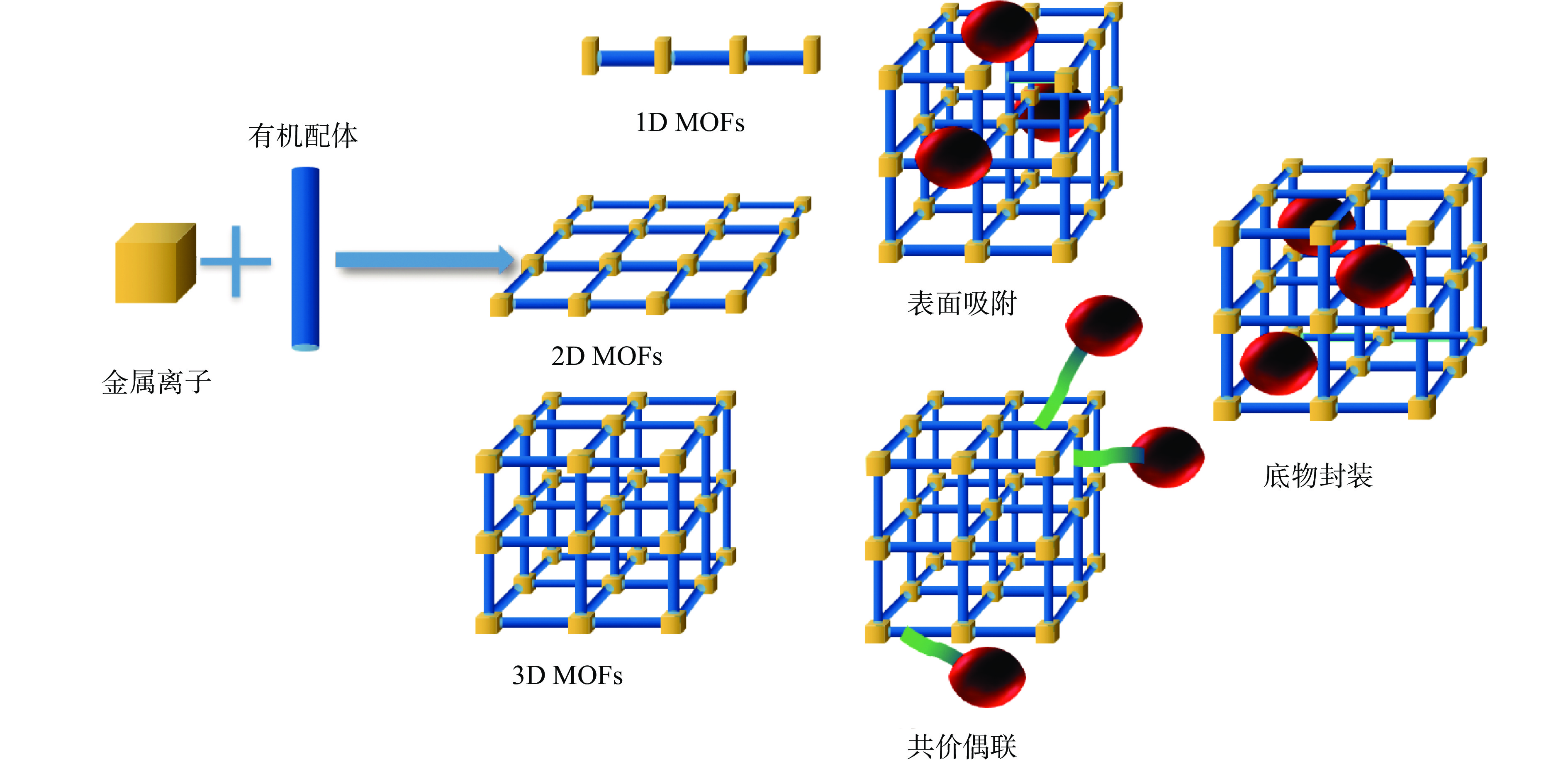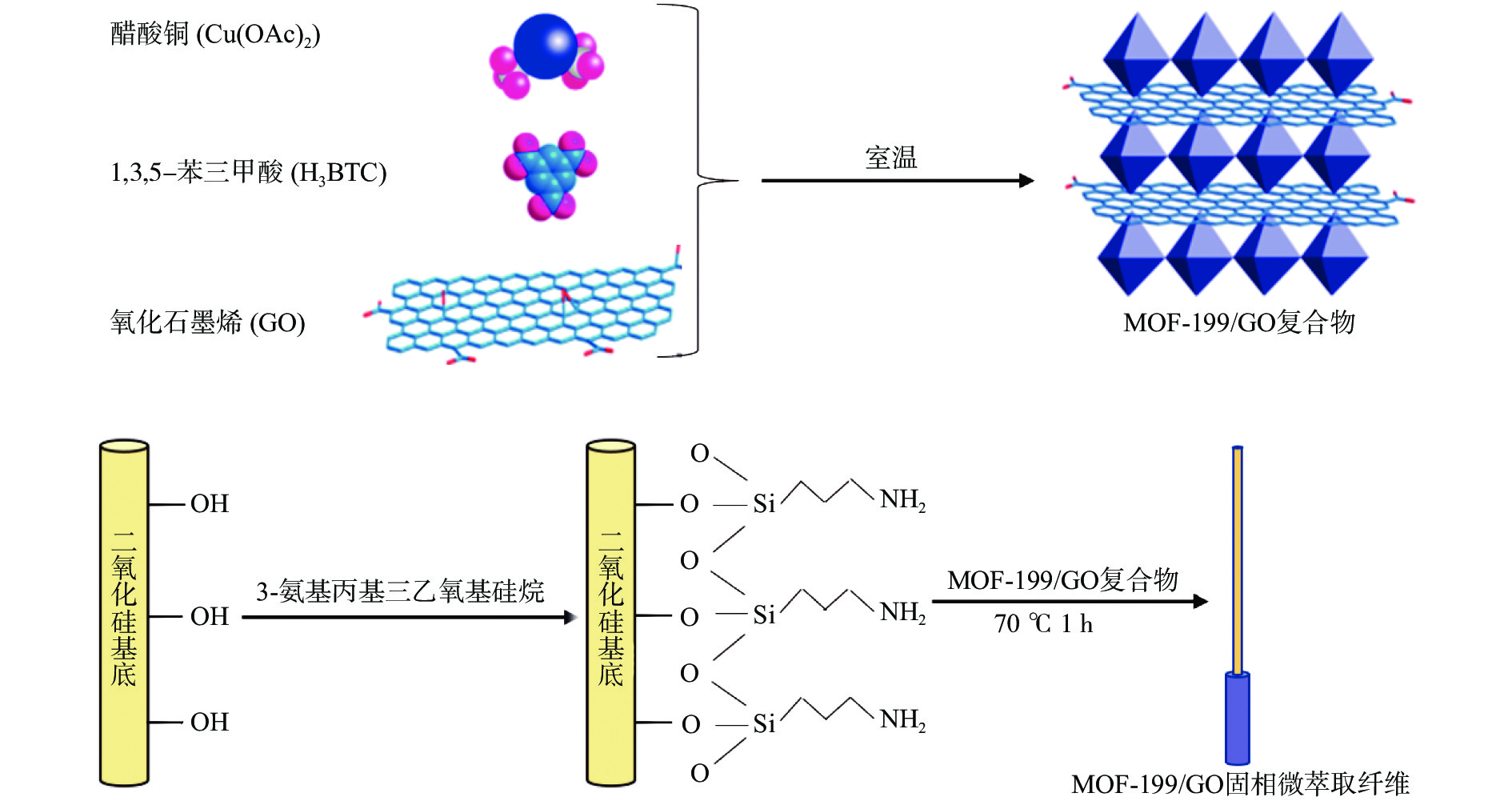Research Progress of Adsorption Extraction of Pesticide and Veterinary Drug Residues in Agricultural Products Based on Metal-organic Frameworks
-
摘要: 农产品中农兽药物的残留是食品安全领域的主要问题之一,有必要对这些药物残留进行含量检测并严格限量。目前的吸附萃取材料如沸石、多壁碳纳米管等存在吸附量少、孔隙易堵塞的问题。金属有机框架(Metal-organic Frameworks,MOFs)因具有可调节孔隙、分级结构、巨大的孔体积和表面积、优异的吸附性能和可回收等特点而被逐渐应用于吸附萃取农产品中的农兽药残。本文综述了MOFs作为吸附剂吸附萃取农产品中农兽药残的应用现状,并分别从农、兽药种类的角度出发就MOFs的吸附应用进行了系统阐述,综合分析了MOFs的优异吸附性能。文章为MOFs吸附萃取农兽药残技术的进一步发展提供参考,为食品安全检测提供了技术借鉴。Abstract: Pesticide and veterinary drug residues in agricultural products are one of the main problems in the field of food safety. It is necessary to test the residual content of these drugs and set strict limits. At present, adsorption extraction materials such as zeolite and multi-walled carbon nanotubes have the problems of low adsorption capacity and easy clogging of pores. Metal-organic frameworks (MOFs) have been gradually applied in the adsorption extraction of pesticide and veterinary drug residues in agricultural products due to their characteristics of adjustable pores, hierarchical structure, large pore volume and surface area, excellent adsorption performance and recyclability. In this paper, the application status of MOFs as adsorbent for extraction of pesticide and veterinary drug residues in agricultural products is reviewed, and the adsorption application of MOFs is systematically described from the perspective of pesticide and veterinary drug types, and the excellent adsorption performance of MOFs is comprehensively analyzed. This paper gives a reference for the further development of MOFs adsorption extraction technology of pesticide and veterinary drug residues, provides a technical reference for food safety detection.
-
Keywords:
- metal-organic framework /
- pesticide /
- veterinary drug /
- adsorption extraction /
- research progress
-
在我国经济高速发展的现代,为保证植物、动物的存活率,常常会使用农药和兽药,造成食用农产品中药物残留,干扰人体内分泌功能,损伤人体健康。目前常见的农药有杀虫剂、除草剂等。常使用的兽药大多为抗生素类、促生长类药物等。毒性研究常将这些农药和兽药与多种疾病联系在一起,如遗传疾病、神经系统疾病、生殖系统疾病、癌症等[1-2]。因此,国家监测机构对农产品中药物残留的检测至关重要。农产品基质复杂,不能直接使用大型仪器检测,检测前需要对样品进行前处理。常用的农药、兽药前处理技术有QuEChERS(Quick、Easy、Cheap、Eff-ective、Rugged、Safe)法、固相萃取柱萃取法和分散固相萃取法等[3-6]。这些技术常使用的吸附剂材料有十八烷基硅烷键合硅胶(C18)、N-丙基乙二胺(Primary Secondary Amine,PSA)、沸石、聚丙烯酰胺、甲壳素、多壁碳纳米管(Multi-walled Carbon Nanotube,MWCNT)等。这些传统吸附材料大多再现性差,孔隙易堵塞,不可重复使用,难以吸附有机物,所以应用受到一定程度的限制。为了满足检测需求,近些年新出现了金属有机骨架(MOFs)及其复合物的吸附材料。
本文旨在综述MOFs及其复合材料作为多功能、高效吸附材料在农产品中农兽药残吸附中的应用,并详细介绍了MOFs吸附这些残留药物的优异性能,包括大的吸附容量、可重复使用性等,为设计性能理想的新型MOFs吸附剂提供有效策略。
1. 金属有机框架(MOFs)
MOFs是由无机金属节点与有机连接体通过配位相互作用形成二维或三维结构的多孔框架,其与目标物的结合方式有表面吸附、共价偶联、底物封装,如图1所示。通常,无机单元是金属离子或金属簇,有机单元是二齿、三齿或四齿有机配体[7],如羧酸盐或其他有机阴离子[8]。
MOFs具有孔隙率高、比表面积大、良好的化学和热稳定性、选择性好、可再生性等优良的性能,其孔隙大小可以根据孔隙率度量、功能、结构和形状从微孔到中孔灵活调整,有利于不同大小的客体分子与MOFs相互结合[9-13]。然而,一些MOFs如MOF-5、MIL-101(V)在暴露于水时会因配体置换或水解发生降解[14-17]。为了解决这个问题,常采用一些方法如氟化、制备MOFs/氧化石墨复合材料和引入疏水官能团等来增强MOFs的水稳定性[18-20]。当然,也有MOFs如MIL-100(Al、Cr、Fe)、MIL-101(Cr )、UiO-66等在水中高度稳定,适用于在水中吸附[21-24]。
MOFs常应用在气体储存、药物输送、传感、催化、吸附等方面[25-26]。常用于吸附农兽药残的MOFs有MILs系列[27-29]、ZIFs系列[30-32]、HKUST-1系列[33]及UiOs系列[34-35],其吸附机制为药物分子通过扩散过程从溶液被吸引到吸附剂材料的表面,到达吸附剂的活性孔,这种吸附结合主要依赖于分子间相互作用力如离子间相互作用、范德华力和π–π相互作用[36-37]。
2. MOFs在吸附农产品中农药残留中的应用
基于MOFs的吸附萃取检测方法,已被逐渐用于农产品中常见农药的快速检测,这些常见农药包括有机磷类农药、有机氯类农药、氨基甲酸酯类农药、新烟碱类杀虫剂、拟除虫菊酯类农药等[38]。表1总结了不同MOFs对农产品中不同农药的吸附能力。
表 1 不同MOFs对农产品中不同农药的吸附Table 1. Adsorption of different pesticides in agricultural products by different MOFs农药 金属有机框架 基质 吸附量(mg/g) 回收率(%) MOFs金属离子 MOFs有机配体 参考文献 有机磷 GNP/MIL-101(Cr) 果汁、蔬菜、蜂蜜 / 84.0~110.0 硝酸铬 对苯二甲酸 [41] Fe3O4@TGA@TMU-6 水稻 / 88.0~107.2 醋酸锌 4,4’-氧二(苯甲酸)、2,5-双(4-吡啶基)-3,4-二氮杂-2,4-己二烯 [42] Fe3O4@ZIF-8@聚合物 梨、甘蓝 8.68~98.04 69.5~94.3 硝酸锌 2-甲基咪唑 [43] 有机氯 MOF-199/GO 龙眼 / 72.2~107.7 醋酸铜 1,3,5-苯三甲酸 [44] Fe3O4@MIL-100(Fe) 茶叶 0.45~0.5 81.46~113.59 氯化铁 1,3,5-苯三甲酸 [45] CD-MOF/TiO2 蜂蜜 / 76.4~114.3 氢氧化钾 环糊精 [46] 氨基甲酸酯 MIL@MIP 梨 3.217 74.16~96.2 硝酸铬 对苯二甲酸 [47] ZIF-8-NPC 白菜 0.1038~0.1201 75.0~92.0 硝酸锌 2-甲基咪唑 [48] MIL-88B 蔬菜 / 97.0~102.0 氯化铁 对苯二甲酸 [49] 拟除虫菊酯 MOFs-MIPs 小麦 474.56 95.7~108.9 硝酸铁 1,3,5-苯三甲酸 [50] Fe3O4@TMU-21 果汁 / 93.0~104.5 硝酸锌 对苯二甲酸 [51] UiO-66 蔬菜 / 60.9~117.5 四氯化锆 对苯二甲酸 [52] 新烟碱 UiO-66-NH2 水果 318,373 92.39~94.37 四氯化锆 2-氨基对苯二甲酸 [53] MIL-101(Cr) 果汁、茶饮 71.43,68.49,50.38 71.04~101.64 硝酸铬 对苯二甲酸 [54] MGO/MIL 水果 / 82.13~102.27 硝酸铬 2-氨基对苯二甲酸 [55] 其它 PVA/甜菊糖/MIL-88A@AuNPs 蔬菜 457 79.3~97.6 氯化铁 反丁烯二酸 [56] M-ZIF-8@ZIF-67 黄瓜 3.244,3.955,5.188,5.729 94.4~99.7 硝酸锌、硝酸钴 2-甲基咪唑 [57] MIL-125-NH2 柚子 / 64.7~116.8 四异丙醇钛 2-氨基对苯二甲酸 [58] 2.1 有机磷农药
有机磷农药是农产品中最常用的杀虫剂之一,市售农产品中有机磷农药的检出和超标现象较为常见[39-40]。MOFs作为吸附剂结合固相萃取技术已被应用到有机磷的样品前处理中,与传统的固相萃取技术相比,此方法更加方便,有机溶剂使用少,处理过程无需频繁离心,其中新型吸附剂的大比表面积和多孔结构能为有机磷农药提供更大的载样空间,增加吸附能力,提高回收率。Moinfar等[41]报道了一种由MOFs和石墨烯纳米粉组合而成的复合吸附剂GNP/MIL-101(Cr),并将其应用于果汁、蔬菜、蜂蜜中有机磷农药的提取,回收率为84.0%~110.0%,萃取时间为20 min,吸附剂可重复使用5次,测得吸附剂比表面积为2476.8 m2/g。另有研究报道了磁性MOFs复合材料用于磁性固相萃取,如Shakourian等[42]合成了吸附萃取水稻中毒死蜱和丙溴磷的磁性金属有机骨架复合物Fe3O4@TGA@TMU-6,其回收率达到了88.0%~107.2%,萃取时间为30 min,吸附剂用量只需2 mg,且材料可重复使用20次。同样,一种能有效提取梨和甘蓝中有机磷农药的新型核壳磁性纳米吸附剂Fe3O4@ZIF-8@聚合物被合成出来,吸附回收率达到了69.5%~94.3%,吸附萃取时间为10 min,吸附剂用量为20 mg,研究表明该吸附材料对9种有机磷农药的最大吸附容量为8.68~98.04 mg/g[43]。总而言之,MOFs用于有机磷农药吸附萃取时,操作简单,吸附剂用量少,有效缩短了预处理时间,降低了有机试剂消耗和操作成本,提高了回收率,有利于大批量样品中多种有机磷的提取,且有机磷结构中含有芳香环、S=O键,能与MOFs的芳香环、-COOH形成π-π键、氢键等相互作用,这些相互作用力是MOFs与有机磷农药吸引结合的重要因素。
2.2 有机氯农药
大多有机氯农药是一类持久性有机污染物,在自然界中难以降解,因此广泛残留在农产品中[59]。传统提取有机氯农药的前处理技术为一般的固相萃取,柱内填充的吸附剂耐性低,多为不可重复使用材料,消耗较大。基于MOFs吸附剂的萃取技术可以克服这个缺点,合成的MOFs吸附剂大多耐持久性,可重复多次使用,降低成本。Zhang等[44]制备了一种用于吸附龙眼中有机氯农药的纤维材料MOF-199/GO(图2),该材料可重复使用140次,这种纤维是用3-氨基丙基三乙氧基硅烷作为交联剂将二氧化硅基底与MOF-199/GO复合物连接在一起制成的,萃取回收率可达72.2%~107.7%,吸附容量用富集系数(萃取后分析物浓度与原始水样中的浓度之比)表示,与市售的聚二甲基硅氧烷(5.2~43.3)、聚二甲基硅氧烷/二乙烯基苯(8.1~43.8)以及氧化石墨烯(2.8~10.6)相比,MOF-199/GO(7.1~108)吸附容量显著高于前三者。此外,由Zhou等[45]合成的用于茶叶中有机氯农药吸附的磁性材料Fe3O4@MIL-100(Fe),重复使用5次后回收率无显著变化,萃取时间仅需要40 s,吸附剂用量只需15 mg,回收率便可达到81.46%~113.59%,Fe3O4@MIL-100(Fe)最大吸附容量与比表面积为0.45~0.5 mg/g和275~300 m2/g,远高于Fe3O4(0.01~0.025 mg/g,5~12.5 m2/g)和Fe3O4@MAA(巯基乙酸)(0.025~0.05 mg/g,12~25 m2/g)。吸附剂比表面积大小是影响吸附剂吸附能力的因素之一,Sun等[46]合成了比表面积更大的复合吸附剂CD-MOF/TiO2,用于提取蜂蜜样品中的有机氯农药,其比表面积与孔隙体积分别为596 m2/g,345 mm3/g,均高于TiO2(473 m2/g,321 mm3/g)与CD/TiO2(443 m2/g,281 mm3/g),吸附剂用量只需10 mg,10 min即可完成萃取,回收率可达76.4%~114.3%。综上,含有MOFs的吸附剂材料吸附容量或比表面积均得到改善,增加了对有机氯农药的吸附能力,且MOFs表面有大量氧基团中和了极性,使其可与低极性的有机氯农药结合,大大缩短了样品处理时间,降低了吸附剂用量并节省了成本。
2.3 氨基甲酸酯类农药
氨基甲酸酯类农药是一类化学合成的广谱杀虫剂,现已广泛用于现代农业中[60]。Qian等[47]研究合成了一种以MIL-101为载体的分子印迹聚合物吸附材料(MIL@MIP),用于萃取梨汁中的速灭威,回收率为74.16%~96.2%,MIL@MIP的比表面积可达1579.43 m2/g,远高于MIP(138.35 m2/g),研究测得MIL@MIP的最大吸附容量为3.217 mg/g,高于该作者之前研究测得的MIP吸附容量(2.77 mg/g)。另一项研究中,同样具有高比表面积的纳米多孔碳ZIF-8-NPC也作为吸附剂从白菜中萃取氨基甲酸酯类农药,研究测得ZIF-8-NPC的比表面积为1319.8 m2/g,总孔体积为1.48 cm3/g,最大吸附容量在0.1038~0.1201 mg/g,相同条件下测得ZIF-8-NPC回收率为75.0%~92.0%,明显高于石墨化炭黑(28.0%~52.0%)、PRS(27.0%~43.0%)以及C18(45.0%~62.0%)的回收率[48]。综上所述,相同条件下,MOFs作为吸附剂处理氨基甲酸酯类农药回收率更高,这可能是因为基于MOFs的吸附剂具有更高的比表面积与更大的吸附容量,极大地增加了其吸附能力。
相比于一些使用传统QuEChERS萃取技术的氨基甲酸酯类农药前处理方法,基于MOFs的改良QuEChERS技术具有更优异的前处理效果。Wang等[49]以MIL-88B为原料合成了QuEChERS的吸附剂,用于测定大白菜、芹菜、长豆、韭菜中的灭多威、异丙威,比表面积高达111.002 m2/g,平均孔径为11.875 nm,萃取回收率为97.0%~102.0%,高于商用吸附剂PSA(75.0%~97.0%)、C18(76.0%~107.0%)和GCB(70.0%~82.0%),吸附剂用量为20 mg,清理时间只需2 min。上述研究中MOFs材料的高比表面积增强了目标物质的吸附扩散能力,提高了农药回收率,且预处理过程无需大型离心装置,缩短了处理时间,是样品预处理的理想吸附剂。
2.4 拟除虫菊酯类农药
拟除虫菊酯类农药因其高效、广谱、光稳定性强等特点,在世界范围内广泛用于农业害虫的防治[61]。Liang等[50]合成了吸附剂材料MOFs-MIPs,用于萃取小麦中的拟除虫菊酯类农药,吸附回收率为95.7%~108.9%,MOFs-MIPs比表面积为213.37 m2/g,孔径为7.09 nm,萃取平衡时间为20 min,最大吸附容量为474.56 mg/g,优于未结合MOFs的MIPs(40 min,103.47 mg/g)。另有一种基于MOFs的复合吸附材料Fe3O4@TMU-21,用以吸附萃取果汁样品中的拟除虫菊酯类农药,吸附剂用量和萃取时间分别为4 mg、6 min,优于Fe3O4/CNTs(40 mg、10 min)、Fe3O4@SiO2-G(20 mg、30 min)、C18-UMS(30 mg、10 min)等一些未结合MOFs的吸附剂材料,吸附剂萃取回收率可达93.0%~104.5%,比表面积为490 m2/g[51]。不同的MOFs材料,比表面积大小存在差异,Mao等[52]合成了萃取蔬菜样品中拟除虫菊酯类农药的吸附材料UiO-66,测得其比表面积为1291 m2/g,总孔体积为0.594 cm3/g,孔径为1.1 nm,大于目标农药粒度大小(0.67~0.88 nm),萃取时间为20 min,回收率可达60.9%~117.5%。综上,MOFs吸附萃取用时短,用量少,纯化效果好,能将大部分粒度较大的蛋白质、糖、色素以及维生素等排除在孔隙之外,减少了基质干扰,拟除虫菊酯中富电子的芳香环、双键、卤素或氰基会主动接近MOFs中的配位不饱和位点,与MOFs形成化学吸附,提高了MOFs对拟除虫菊酯农药的吸附亲和力,增强了其吸附能力。
2.5 新烟碱类农药
新烟碱类杀虫剂是世界上增长最快的杀虫剂,现已用于140多种农田作物中[62]。Xu等[53]制备了UiOs系列的吸附材料UiO-66-NH2,用于吸附水果样品中的吡虫啉和噻虫嗪,吸附回收率为92.39%~94.37%,测得最大吸附容量分别为318、373 mg/g,吸附时间为15 min,吸附剂可重复使用8次。除此之外,MILs系列的吸附材料也被用于吸附萃取农产品中的新烟碱类农药,如MIL-101(Cr),其被用于果汁和茶饮中新烟碱类农药的吸附,吸附剂用量为20 mg,吸附时间为5 min,回收率达到了71.04%~101.64%,测得MIL-101(Cr)比表面积为2236.2 m2/g,其对啶虫脒、噻虫啉、吡虫啉的最大吸附容量分别为71.43、68.49、50.38 mg/g,材料可重复使用8次[54]。同样,Ghiasi等[55]也研究了MILs系列材料,并在MIL-101(Cr)的基础上结合磁性粒子合成了复合吸附材料MGO/MIL,将其用于水果样品中新烟碱类杀虫剂的萃取,回收率为82.13%~102.27%,研究表明MGO/MIL比表面积为1612.70 m2/g,吸附剂用量为20 mg,萃取时间为20 min,可重复使用20次,在相同条件下,对比MGO/MIL、GO以及MGO的吸附回收率,结果为MGO/MIL(90.0%~93.0%)>MGO(60.0%~63.5%)>GO(59.5%~63.0%)。由此证明,MOFs吸附剂应用于新烟碱农药的萃取,吸附能力强,吸附回收率高,吸附剂具有良好的可回收性且用量少,降低了成本,新烟碱化合物结构中含N官能团,能与MOFs形成Lewis酸碱相互作用,分子间作用力与MOFs的大比表面积共同铸就了MOFs的高吸附能力。
2.6 其它类农药
一些农药如氟虫腈、甲基对硫磷、杀螟松、甲基苯丙嗪、阿米替林、阿特拉津等也被用于农业防护中。Hejabri等[56]合成了一种新型吸附剂PVA/甜菊糖/MIL-88A@AuNPs,用以萃取蔬菜样品中的8种农药,回收率达到了79.3%~97.6%,最大吸附容量为457 mg/g,单一PVA/甜菊糖的比表面积和孔隙体积分别为9.6 m2/g、0.029 cm3/g,结合MOFs材料后,比表面积与孔隙体积分别增加至31.6 m2/g、0.1852 cm3/g。为了更高效地提取黄瓜样品中的氟虫腈及其代谢物,Li等[57]合成了比表面积更大的吸附材料M-ZIF-8@ZIF-67,比表面积可达到219 m2/g,回收率为94.4%~99.7%,其对氟虫腈脱硫剂、氟虫腈、氟虫腈硫化物以及氟虫腈砜的吸附容量分别为3.244、3.955、5.188、5.729 mg/g。另一项研究中,吸附材料MIL-125-NH2被合成出并用于检测柚子中的农药残留,其比表面积为1283 m2/g,孔径为0.5~0.8 nm,萃取时间为10 min,回收率可达64.7%~116.8%,MIL-125-NH2的均匀微孔具有分子筛作用,能阻挡蛋白质(直径>1 nm)等大基质化合物进入,有效提高了萃取效率[58]。总之,结合MOFs的吸附剂材料比表面积与孔隙率得到了显著的改善,为农药提供了广泛的接触面积,其本身结构的特殊性(苯环、羟基等)为农药提供了特异性结合位点,提高了MOFs的吸附能力,减少了分散剂和有机溶剂的消耗,是一种环境友好型的吸附剂材料,有望成为食品质量安全检测和监测的固体吸附剂。
3. MOF在吸附农产品中兽药残留中的应用
目前常用的兽药大部分为抗微生物类兽药(β-内酰胺类、四环素类、喹诺酮类、磺胺类等),其次为抗寄生虫药、生长调节药、激素药等。为了提高食品安全性,基于MOFs的快速检测对动物源性食品安全筛查具有重要价值。表2总结了不同MOFs对农产品中不同兽药的吸附能力。
表 2 不同MOFs对农产品中不同兽药的吸附Table 2. Adsorption of different veterinary drugs in agricultural products by different MOFs兽药 金属有机框架 基质 吸附量(mg/g) 回收率(%) MOFs金属离子 MOFs有机配体 参考文献 β-内酰胺 MIL-53(Al) 牛奶 / 81.1~100.7 硝酸铝 1,4-苯二甲酸 [64] Zn-Al-LDH/ZIF-8 牛奶 / 96.0~110.0 硝酸锌 2-甲基咪唑 [65] MMOF 牛奶 250.5 99.5~100.0 硝酸铜 对苯二甲酸 [66] 四环素 MOF1 乳制品 29.78 71.2~99.2 氯化锌 1,3,5-三((吡啶-4-甲硫基)甲基)苯 [67] Eu/Zr-MOF 猪肉 289 93.16~104.16 硝酸铕、氯化锆 对苯二甲酸 [68] Eu-CBO@ZIF-8 牛奶、蜂蜜 377.07 96.9~104.6 硝酸锌 2-甲基咪唑 [69] 喹诺酮 ZIF-8@整体柱复合物 蜂蜜 / 80.2~117.0 硝酸锌 2-甲基咪唑 [70] HKUST-1@polymer 牛奶 / 103.0~119.0 醋酸铜 1,3,5-苯三甲酸 [71] NH2-MIL-125(Ti) 牛奶 60.32 80.7~103.5 纯钛箔 2-氨基对苯二甲酸 [72] 磺胺 NH2-UiO-66、NH2-MIL-101、ZIF-8 牛奶 139.64,29.98,36.35 82.30~105.62 氯化锆、硝酸锌 对苯二甲酸
2-甲基咪唑[73] MIL-101(Cr)@GO 牛奶 / 79.83~103.8 硝酸铬 对苯二甲酸 [74] MOF/MGO@MIP 蜂蜜、牛奶 42.65 81.38~96.71 氯化铝 对苯二甲酸 [75] 其它 UiO-67@GO@Fe3O4 蜂蜜 / 70.5~103.4 氯化锆 对苯二甲酸 [76] MIL-101(Cr)@GO 鸡胸肉 / 88.9~102.3 硝酸铬 对苯二甲酸 [77] Fe3O4@ZIF-8 鱼、猪肉 538,753,575,435 ng 73.8~96.7 硝酸锌 2-甲基咪唑 [78] 3.1 β-内酰胺类兽药
β-内酰胺类兽药杀菌活性强,适应症广,广泛应用于畜牧业,进入人体会破坏肠道菌群平衡,引起过敏反应[63]。为萃取牛奶样品中的青霉素G、青霉素V、苯唑西林、邻氯青霉素、双氯西林和萘西林等,Lirio等[64]合成了铝基金属有机骨架吸附剂MIL-53(Al),吸附剂用量3 mg,回收率可达81.1%~100.7%,吸附机制可能取决于青霉素结构中含有的N、H、OH基团与MOFs羧酸配体产生的氢键相互作用。同样的,Khoobi等[65]合成的纳米吸附剂Zn-Al-LDH/ZIF-8,可能也是依靠氢键、静电作用、π-π堆积和疏水作用吸附结合牛奶样品中的青霉素,加标回收率可达96.0%~110.0%,萃取时间为30 min。不同于上述吸附剂,一种带磁金属有机骨架吸附剂MMOF被制备出来,用以萃取牛奶中的氨苄西林,萃取时间大大缩短,仅需4 min便可达到平衡,相比于商用聚合纤维(30 min),C18复合材料(60 min)和介孔二氧化硅(15 min),同样缩短了萃取时间,吸附回收率为99.5%~100.0%,其比表面积为300.00 m2/g,孔径为5.35 nm,最大吸附容量为250.5 mg/g,优于商用活性炭(30.5 mg/g)与L-胱氨酸改性沸石(0.6 mg/g)[66]。综上所述,MOFs吸附剂材料萃取β-内酰胺类兽药时稳定性高,重现性好,且用时少,用量少,吸附能力强,回收率高,提升了预处理效率,提取过程步骤简单,无需昂贵的设备,MOFs材料作为吸附剂在亲水性化合物的萃取上具有很高的潜力。
3.2 四环素类兽药
四环素是一类广谱抗菌药,在人体中易引起胃肠道紊乱和肝毒性,通常用于治疗动物的某些疾病或作为饲料添加剂促进动物生长[79]。Li等[67]报道了一种锌基金属有机骨架MOF1作为吸附剂萃取乳制品中残留的四环素,回收率达到了71.2%~99.2%,稳定性实验中,MOF1置于水中7 d,结构依然保持完整,测得MOF1的比表面积与孔径分别为11.86 m2/g、4.7 nm,最大吸附容量为29.78 mg/g,优于活性炭(1.98 mg/g)、壳聚糖(23.92 mg/g)、浮石(20.02 mg/g)及纳米纤维素(7.73 mg/g)。另有研究发现了一种双金属有机框架材料Eu/Zr-MOF,用于猪肉样品中四环素类兽药的快速去除,吸附材料的负载能力高达289 mg/g,回收率为93.16%~104.16%,高吸附能力可能是因为吸附剂中的Zr-O基团具有Lewis酸的特征,可以与四环素中的碱性胺基结合[68]。同样具有高吸附容量的杂化材料Eu-CBO@ZIF-8被Wu等[69]设计合成,并用于去除牛奶与蜂蜜中的四环素残留,研究测得其吸附容量为377.07 mg/g,比表面积为327 m2/g,加标回收率为96.9%~104.6%。总而言之,基于MOFs的吸附材料具有更大的比表面积,吸附能力更强,在水中稳定性好,四环素结构中含有多个酚羟基,极性增强,可以与MOFs的开放金属位点强烈相互作用,也可以与MOFs羧基发生氢键作用,其次,四环素分子中酮的电子供体基团产生的π电子受体可以促进π-π相互作用,这些都有助于增强MOFs吸附剂对四环素类兽药的吸附能力,该吸附剂有望成为食品样品中多种兽药残留的常规提取吸附剂。
3.3 喹诺酮类兽药
喹诺酮类药物是人工合成的抗菌药,残留药物会引起人体过敏反应或诱导病原体对抗生素产生耐药性,现多被用于鸡场以治疗蛋鸡的疾病[80]。Pang等[70]制备了一种用于蜂蜜中喹诺酮类药物萃取的吸附材料ZIF-8@整体柱复合物,萃取回收率为80.2%~117.0%,研究测得吸附剂比表面积为113.0 m2/g,远高于引入ZIF-8之前的整体柱材料(40.1 m2/g)。在另一项研究中,H´ector等[71]合成了一种比表面积更大的复合吸附剂材料HKUST-1@polymer,将其应用于牛奶中氟喹诺酮类药物的萃取,其比表面积为170 m2/g,回收率达到了103.0%~119.0%,与其它吸附剂相比,HKUST-1@polymer用量只需100 μg,远小于C18(4 mg)、Zr-Fe-C(5 mg)和MIP(40 mg)的用量。此外,一种基于MOFs的表面分子印迹吸附材料RAM-MIPs(NH2-MIL-125(Ti))被合成出,用于萃取牛奶中的氧氟沙星、培氟沙星、诺氟沙星、恩诺沙星和加替沙星,其加标回收率为80.7%~103.5%,该吸附材料的负载量为60.32 mg/g,高于文献报道水平(MMIP 7.0 mg/g[81]、MCCNs@MIP 45.64 mg/g[82])[72]。综上,MOFs或基于MOFs合成的复合材料是高效、多功能的萃取吸附剂,其优异的大比表面积为喹诺酮类兽药提供了更多的活性位点,增加了吸附容量,提高了吸附能力,这类吸附剂材料还可以直接从真实样品中提取喹诺酮类兽药,无需进行蛋白沉淀处理,消除了基质干扰的影响,减少了有机溶剂的使用,有效简化了操作过程,在实际应用中,直接提取痕量喹诺酮类兽药具有广阔的前景。
3.4 磺胺类兽药
磺胺类抗生素是一种重要的广谱抗生素,用于提高饲料转化率、促进动物生长等,在动物性食品中经常出现严重的药物残留超标现象[83]。Wang等[73]采用三种常见的MOFs(NH2-UiO-66、NH2-MIL-101和ZIF-8)对牛奶中的磺胺二甲嘧啶进行了吸附试验,回收率为82.30%~105.62%,3种MOFs的比表面积分别为1103.54、109.42、1352.08 m2/g,吸附容量分别为139.64、29.98、36.35 mg/g,且NH2-UiO-66的吸附容量大于NH2-BPCs(95.8 mg/g)、MIPs(22.5 mg/g)。另外,通过Jia等[74]的研究发现了一种新型复合材料MIL-101(Cr)@GO,将其用于吸附牛奶中的微量磺胺类兽药,材料表征测得MIL-101(Cr)@GO的比表面积为3351.64 m2/g,总孔隙体积为2.2756 cm3/g,回收率可达到79.83%~103.8%,吸附材料可重复使用5次,研究比较了MIL-101(Cr)@GO与活性炭对磺胺类兽药的萃取回收率,结果远高于活性炭(20.0%~32.0%)。此外,Han等[75]研究合成了一种磁性复合MOFs材料MOF/MGO@MIP,用于吸附蜂蜜和牛奶中的磺胺类兽药,吸附回收率为81.38%~96.71%,研究表明其最大吸附容量为42.65 mg/g,比表面积为86.09 m2/g,吸附剂可循环使用7次。总之,MOFs吸附剂对磺胺类兽药有良好的萃取效果,吸附剂的可回收性降低了实验成本,大的比表面积增加了吸附容量,MOFs吸附剂可成为复杂基质中萃取磺胺类兽药的高效吸附剂材料,磺胺类化合物结构中含有芳香环、O、H以及氨基基团,可以与MOFs结构中的芳香环、羧基基团形成π-π共轭效应与氢键相互作用,这些分子间相互作用力促进了MOFs与磺胺类药物的特异性结合,提高了萃取能力。
3.5 其它类兽药
抗寄生虫药、生长调节药以及激素药也是较为广泛使用的兽药,非法添加到动物饲料中的生长调节药与激素药可能会造成肉类食品中药物残留。Xu等[76]制备了一种萃取蜂蜜中硝基咪唑和苯并咪唑的新型吸附材料UiO-67@GO@Fe3O4,其比表面积、孔隙体积分别为184.76 m2/g、0.11 cm3/g,吸附回收率为70.5%~103.4%,萃取平衡时间为10 min,相比文献报道的C18(40~60 min[84]),吸附用时明显缩短。另有研究合成了复合吸附剂MIL-101(Cr)@GO,用于提取鸡胸肉中的甲硝唑、替硝唑及氯霉素,MIL-101(Cr)@GO的比表面积与孔隙体积分别为3351.46 m2g、2.2756 cm3g,远大于GO(98.382 m2g、0.1044 cm3g),该吸附剂的萃取回收率可达88.9%~102.3%,远高于GO(9.0%~12.0%)的回收率[77]。此外,一种基于Fe3O4@ZIF-8的分子印迹吸附材料MZMIP被用于吸附鱼肉和猪肉中的雌酮、雌二醇、雌三醇和炔雌醇,并且吸附回收率可达到73.8%~96.7%,提取时间为15 min,明显短于Fe3O4@SiO2@MIP(MMIP)(25 min)的吸附时间[78]。研究表明,在4 mg/L的混合标准溶液中,MZMIP对4种雌激素的最大萃取容量为538、753、575和435 ng,优于MMIP的最大萃取容量(309、385、328和216 ng),MZMIP的比表面积、孔隙体积分别为184.59 m2g、0.21 cm3g,均高于MMIP(87.1 m2g、0.085 cm3g)。综上可得,基于MOFs的吸附材料可显著缩短萃取农产品中兽药的时间,提高样品制备效率,且上述MOFs材料具有高比表面积、高孔隙率、高重复性,这些优点导致了其对农产品中兽药的高吸附容量,并降低了成本,是一类经济有效、高度稳定,高吸附能力的兽药萃取吸附剂。
4. 结论
MOFs作为一种新型材料,在农产品中农兽药残吸附应用中具有巨大的潜力。这篇综述揭示了不同种类的MOFs及其复合材料在吸附分离农产品中农兽药残时表现出的优异性能及研究进展,总结了各种农产品中不同种类的农药和兽药与MOFs之间的作用方式,MOFs对农兽药残的优异吸附能力,MOFs的可回收使用性能等。尽管MOFs吸附剂对农药、兽药表现出了优异的吸附性能,但仍然存在一些问题需要解决,例如,MOFs吸附中通常涉及多种复杂的相互作用,一方面,强相互作用有利于农兽药残的吸附,但同时不利于解吸;另一方面,每种相互作用的贡献程度比较模糊,因此,有必要进一步探索主客体之间的复杂相互作用与吸附-解吸之间的关系,以期能够同时实现有效吸附、容易解吸。其次,目前的MOFs材料存在无法在有机溶剂中萃取农兽药残的缺陷。另外,MOFs吸附速度的影响机制尚不明确、基于混合金属合成的MOFs难以确定混合金属的定位与配比、MOFs的功能性配体比较单一、MOFs合成时间较长等缺陷也需要被关注。本文建议相关科研人员应充分认识MOFs的各方面特性,全面考虑需要解决的问题,以期在未来合成具有良好的水热稳定性和化学稳定性、超大的比表面积、可控的孔径、合适的吸附位点以及低成本环境友好的理想MOFs吸附剂,进而促进农产品中农兽药残吸附萃取技术的进一步发展。
-
表 1 不同MOFs对农产品中不同农药的吸附
Table 1 Adsorption of different pesticides in agricultural products by different MOFs
农药 金属有机框架 基质 吸附量(mg/g) 回收率(%) MOFs金属离子 MOFs有机配体 参考文献 有机磷 GNP/MIL-101(Cr) 果汁、蔬菜、蜂蜜 / 84.0~110.0 硝酸铬 对苯二甲酸 [41] Fe3O4@TGA@TMU-6 水稻 / 88.0~107.2 醋酸锌 4,4’-氧二(苯甲酸)、2,5-双(4-吡啶基)-3,4-二氮杂-2,4-己二烯 [42] Fe3O4@ZIF-8@聚合物 梨、甘蓝 8.68~98.04 69.5~94.3 硝酸锌 2-甲基咪唑 [43] 有机氯 MOF-199/GO 龙眼 / 72.2~107.7 醋酸铜 1,3,5-苯三甲酸 [44] Fe3O4@MIL-100(Fe) 茶叶 0.45~0.5 81.46~113.59 氯化铁 1,3,5-苯三甲酸 [45] CD-MOF/TiO2 蜂蜜 / 76.4~114.3 氢氧化钾 环糊精 [46] 氨基甲酸酯 MIL@MIP 梨 3.217 74.16~96.2 硝酸铬 对苯二甲酸 [47] ZIF-8-NPC 白菜 0.1038~0.1201 75.0~92.0 硝酸锌 2-甲基咪唑 [48] MIL-88B 蔬菜 / 97.0~102.0 氯化铁 对苯二甲酸 [49] 拟除虫菊酯 MOFs-MIPs 小麦 474.56 95.7~108.9 硝酸铁 1,3,5-苯三甲酸 [50] Fe3O4@TMU-21 果汁 / 93.0~104.5 硝酸锌 对苯二甲酸 [51] UiO-66 蔬菜 / 60.9~117.5 四氯化锆 对苯二甲酸 [52] 新烟碱 UiO-66-NH2 水果 318,373 92.39~94.37 四氯化锆 2-氨基对苯二甲酸 [53] MIL-101(Cr) 果汁、茶饮 71.43,68.49,50.38 71.04~101.64 硝酸铬 对苯二甲酸 [54] MGO/MIL 水果 / 82.13~102.27 硝酸铬 2-氨基对苯二甲酸 [55] 其它 PVA/甜菊糖/MIL-88A@AuNPs 蔬菜 457 79.3~97.6 氯化铁 反丁烯二酸 [56] M-ZIF-8@ZIF-67 黄瓜 3.244,3.955,5.188,5.729 94.4~99.7 硝酸锌、硝酸钴 2-甲基咪唑 [57] MIL-125-NH2 柚子 / 64.7~116.8 四异丙醇钛 2-氨基对苯二甲酸 [58] 表 2 不同MOFs对农产品中不同兽药的吸附
Table 2 Adsorption of different veterinary drugs in agricultural products by different MOFs
兽药 金属有机框架 基质 吸附量(mg/g) 回收率(%) MOFs金属离子 MOFs有机配体 参考文献 β-内酰胺 MIL-53(Al) 牛奶 / 81.1~100.7 硝酸铝 1,4-苯二甲酸 [64] Zn-Al-LDH/ZIF-8 牛奶 / 96.0~110.0 硝酸锌 2-甲基咪唑 [65] MMOF 牛奶 250.5 99.5~100.0 硝酸铜 对苯二甲酸 [66] 四环素 MOF1 乳制品 29.78 71.2~99.2 氯化锌 1,3,5-三((吡啶-4-甲硫基)甲基)苯 [67] Eu/Zr-MOF 猪肉 289 93.16~104.16 硝酸铕、氯化锆 对苯二甲酸 [68] Eu-CBO@ZIF-8 牛奶、蜂蜜 377.07 96.9~104.6 硝酸锌 2-甲基咪唑 [69] 喹诺酮 ZIF-8@整体柱复合物 蜂蜜 / 80.2~117.0 硝酸锌 2-甲基咪唑 [70] HKUST-1@polymer 牛奶 / 103.0~119.0 醋酸铜 1,3,5-苯三甲酸 [71] NH2-MIL-125(Ti) 牛奶 60.32 80.7~103.5 纯钛箔 2-氨基对苯二甲酸 [72] 磺胺 NH2-UiO-66、NH2-MIL-101、ZIF-8 牛奶 139.64,29.98,36.35 82.30~105.62 氯化锆、硝酸锌 对苯二甲酸
2-甲基咪唑[73] MIL-101(Cr)@GO 牛奶 / 79.83~103.8 硝酸铬 对苯二甲酸 [74] MOF/MGO@MIP 蜂蜜、牛奶 42.65 81.38~96.71 氯化铝 对苯二甲酸 [75] 其它 UiO-67@GO@Fe3O4 蜂蜜 / 70.5~103.4 氯化锆 对苯二甲酸 [76] MIL-101(Cr)@GO 鸡胸肉 / 88.9~102.3 硝酸铬 对苯二甲酸 [77] Fe3O4@ZIF-8 鱼、猪肉 538,753,575,435 ng 73.8~96.7 硝酸锌 2-甲基咪唑 [78] -
[1] HSIEH H Y, HUANG K C, CHENG J O, et al. Environmental effects on the bioaccumulation of PAHs in marine zooplankton in Gaoping coastal waters, Taiwan: Concentration, distribution, profile, and sources[J]. Mar Pollut Bull,2019,144:68−78. doi: 10.1016/j.marpolbul.2019.04.048
[2] YALI Z P, JADID A P, SAMIN L A. Modeling of retention time for polychlorinated biphenyl congeners in human adipose tissue using quantitative structure-retention relationship methodology[J]. International Journal of Environmental Science and Technology,2017,14(11):2357−2366. doi: 10.1007/s13762-017-1304-4
[3] 林守二, 杨丽娟, 郑仁锦, 等. 超高效液相色谱-四极杆-飞行时间质谱快速筛查蔬菜中18种农药残留[J]. 分析科学学报,2021,37(3):279−286. [LIN S E, YANG L J, ZHENG R J, et al. Rapid screening of 18 pesticide residues in vegetables by ULTRA performance liquid chromatography-quadrupole-time of flight mass spectrometry[J]. Journal of Analytical Science,2021,37(3):279−286. doi: 10.13526/j.issn.1006-6144.2021.03.002 [4] 魏玉霞, 王芳, 左郡, 等. QuEChERS-超高效液相色谱-串联质谱法同时测定淡水鱼和淡水虾中的11种喹诺酮类兽药残留量[J]. 食品安全质量检测学报,2021,12(7):2906−2912. [WEI Y X, WANG F, ZUO J, et al. Simultaneous determination of 11 quinolones residues in freshwater fish and shrimp by QuEChERS-ULTRA performance liquid chromatography-tandem mass spectrometry[J]. Journal of Food Safety and Quality,2021,12(7):2906−2912. doi: 10.19812/j.cnki.jfsq11-5956/ts.2021.07.061 [5] 王伟民, 孙强, 沈沁怡, 等. 超高压液相色谱法测定水果和蔬菜中虫螨腈及其代谢物以及在甘蓝中的残留评价应用[J]. 分析测试学报,2021,40(12):1706−1712. [WANG W M, SUN Q, SHEN Q Y, et al. Determination of chlorfenonil and its metabolites in fruits and vegetables by ULTRA high pressure liquid chromatography and application of residue evaluation in cabbage[J]. Journal of Instrumental Analysis,2021,40(12):1706−1712. doi: 10.19969/j.fxcsxb.21032403 [6] 梁倩文, 朱国婵, 郑超红, 等. 全自动固相萃取-液相色谱串联质谱法测定动物源性食品中53种常见兽药残留[J]. 食品安全质量检测学报,2021,12(10):4161−4173. [LIANG Q W, ZHU G C, ZHENG C H, et al. Determination of 53 common veterinary drug residues in food of animal origin by automatic solid phase extraction-liquid chromatography tandem mass spectrometry[J]. Journal of Food Safety and Quality,2021,12(10):4161−4173. doi: 10.19812/j.cnki.jfsq11-5956/ts.2021.10.043 [7] FEREY G. Hybrid porous solids: Past, present, future[J]. Chem Soc Rev,2008,37(1):191−214. doi: 10.1039/B618320B
[8] LU W, WEI Z, GU Z Y, et al. Tuning the structure and function of metal-organic frameworks via linker design[J]. Chemical Society Reviews,2014,43(16):5561−5593. doi: 10.1039/C4CS00003J
[9] ZHAN X Q, ZHANG Y, XIE L, et al. Magnetically treated Zr-based UiO-type porous coordination polymers study on adsorption of azo dye[J]. Microporous and Mesoporous Materials,2020:306. doi: 10.1016/j.micromeso.2020.110291
[10] XIN S, YANG N, GAO F, et al. Three-dimensional polypyrrole-derived carbon nanotube framework for dye adsorption and electrochemical supercapacitor[J]. Applied Surface Science,2017,414:218−223. doi: 10.1016/j.apsusc.2017.04.109
[11] DHAKA S, KUMAR R, DEEP A, et al. Metal-organic frameworks (MOFs) for the removal of emerging contaminants from aquatic environments[J]. Coordination Chemistry Reviews,2019,380:330−352. doi: 10.1016/j.ccr.2018.10.003
[12] OMAR M Y. Reticular synthesis and the design of new materials[J]. Nature,2003,6941(423):705−714.
[13] KHAN N A, HASAN Z, JHUNG S H. Adsorptive removal of hazardous materials using metal-organic frameworks (MOFs): A review[J]. J Hazard Mater,2013,244-245:444−456. doi: 10.1016/j.jhazmat.2012.11.011
[14] KANG I J, KHAN N A, HAQUE E, et al. Chemical and thermal stability of isotypic metal-organic frameworks: Effect of metal ions[J]. Chemistry,2011,17(23):6437−6442. doi: 10.1002/chem.201100316
[15] JOHN J L. Virtual high throughput screening confirmed experimentally: Porous coordination polymer hydration[J]. Journal of the American Chemical Society,2009,43(131):15834−15842.
[16] JEFFERY A G. The interaction of water with MOF-5 simulated by molecular dynamics[J]. Journal of the American Chemical Society,2006,33(128):S1−S4.
[17] VAN DER VOORT P, LEUS K, LIU Y Y, et al. Vanadium metal-organic frameworks: Structures and applications[J]. New J Chem,2014,38(5):1853−1867. doi: 10.1039/C3NJ01130E
[18] YANG C, KAIPA U, MATHER Q Z, et al. Fluorous metal-organic frameworks with superior adsorption and hydrophobic properties toward oil spill cleanup and hydrocarbon storage[J]. J Am Chem Soc,2011,133(45):18094−18097. doi: 10.1021/ja208408n
[19] ZU D D, LU L, LIU X Q, et al. Improving hydrothermal stability and catalytic activity of metal-organic frameworks by graphite oxide incorporation[J]. The Journal of Physical Chemistry C,2014,118(34):19910−19917. doi: 10.1021/jp506335x
[20] WU T, SHEN L, LUEBBERS M, et al. Enhancing the stability of metal-organic frameworks in humid air by incorporating water repellent functional groups[J]. Chem Commun (Camb),2010,46(33):6120−6122. doi: 10.1039/c0cc01170c
[21] JEREMIAS F, KHUTIA A, HENNINGER S K, et al. MIL-100 (Al, Fe) as water adsorbents for heat transformation purposes-a promising application[J]. J Mater Chem,2012,22(20):10148−10151. doi: 10.1039/C2JM15615F
[22] CYCHOSZ K A, MATZGER A J. Water stability of microporous coordination polymers and the adsorption of pharmaceuticals from water[J]. Langmuir,2010,26(22):17198−17202. doi: 10.1021/la103234u
[23] EHRENMANN J, HENNINGER S K, JANIAK C. Water adsorption characteristics of MIL-101 for heat-transformation applications of MOFs[J]. European Journal of Inorganic Chemistry,2011,2011(4):471−474. doi: 10.1002/ejic.201001156
[24] JASMINA HAFIZOVIC C. A new zirconium inorganic building brick forming metal organic frameworks with exceptional stability[J]. Journal of the American Chemical Society,2008,42(130):13850−13851.
[25] NESHASTEHGAR M, RAHMANI P, SHOJAEI A, et al. Enhanced adsorption removal performance of UiO-66 by rational hybridization with nanodiamond[J]. Microporous and Mesoporous Materials,2020:296. doi: 10.1016/j.micromeso.2020.110008
[26] ZHAO R, MA T, ZHAO S, et al. Uniform and stable immobilization of metal-organic frameworks into chitosan matrix for enhanced tetracycline removal from water[J]. Chemical Engineering Journal,2020:382. doi: 10.1016/j.cej.2019.122893
[27] HE X, ZHOU Y, YANG W, et al. Microwave assisted magnetic solid phase extraction using a novel amino-functionalized magnetic framework composite of type Fe3O4-NH2@MIL-101 (Cr) for the determination of organochlorine pesticides in soil samples[J]. Talanta,2019,196:572−578. doi: 10.1016/j.talanta.2018.12.019
[28] ABDELHAMEED R M, TAHA M, ABDEL-GAWAD H, et al. Amino-functionalized Al-MIL-53 for dimethoate pesticide removal from wastewater and their intermolecular interactions[J]. Journal of Molecular Liquids,2021:327. doi: 10.1016/j.molliq.2020.114852
[29] SOURY S, FIROOZICHAHAK A, NEMATOLLAHI D, et al. Needle-trap device packed with the MIL-100 (Fe) metal-organic framework for the extraction of the airborne organochlorine pesticides[J]. Microchemical Journal,2021:171. doi: 10.1016/j.microc.2021.106866
[30] LI S, JIANG J, HO S H, et al. Bimetallic nitrogen-doped porous carbon derived from ZIF-L&FeTPP@ZIF-8 as electrocatalysis and application for antibiotic wastewater treatment[J]. Separation and Purification Technology,2021:276. doi: 10.1016/j.seppur.2021.119259
[31] CHENG Y, MA B, TAN C P, et al. Hierarchical macro-microporous ZIF-8 nanostructures as efficient nano-lipase carriers for rapid and direct electrochemical detection of nitrogenous diphenyl ether pesticides[J]. Sensors and Actuators B: Chemical,2020:321. doi: 10.1016/j.snb.2020.128477
[32] NIU M, LI Z, HE W, et al. Attapulgite modified magnetic metal-organic frameworks for magnetic solid phase extraction and determinations of benzoylurea insecticides in tea infusions[J]. Food Chem,2020,317:126425. doi: 10.1016/j.foodchem.2020.126425
[33] JIANG Y, QIN Z, SONG X, et al. Facile preparation of metal organic framework-based laboratory semi-automatic micro-extraction syringe packed column for analysis of parabens in vegetable oil samples[J]. Microchemical Journal,2020:158. doi: 10.1016/j.microc.2020.105200
[34] DUO H, WANG Y, WANG L, et al. Zirconium (IV)-based metal-organic frameworks (UiO-67) as solid-phase extraction adsorbents for extraction of phenoxyacetic acid herbicides from vegetables[J]. J Sep Sci,2018,41(22):4149−4158. doi: 10.1002/jssc.201800784
[35] MOTAGHI H, ARABKHANI P, PARVINNIA M, et al. Simultaneous adsorption of cobalt ions, azo dye, and imidacloprid pesticide on the magnetic chitosan/activated carbon@UiO-66 bio-nanocomposite: Optimization, mechanisms, regeneration, and application[J]. Separation and Purification Technology,2022:284. doi: 10.1016/j.seppur.2021.120258
[36] SIIPOLA V, PFLUGMACHER S, ROMAR H, et al. Low-cost biochar adsorbents for water purification including microplastics removal[J]. Applied Sciences, 2020, 10(3).
[37] KUMAR V, KUMAR S, KIM K H, et al. Metal organic frameworks as potent treatment media for odorants and volatiles in air[J]. Environ Res,2019,168:336−356. doi: 10.1016/j.envres.2018.10.002
[38] HAMZA R A, IORHEMEN O T, TAY J H. Occurrence, impacts and removal of emerging substances of concern from wastewater[J]. Environmental Technology & Innovation,2016,5:161−175. doi: 10.1016/j.eti.2016.02.003
[39] FOSU P O, DONKOR A, ZIWU C, et al. Surveillance of pesticide residues in fruits and vegetables from Accra Metropolis markets, Ghana, 2010–2012: A case study in Sub-Saharan Africa[J]. Environmental Science and Pollution Research,2017,24(20):17187−17205. doi: 10.1007/s11356-017-9287-8
[40] CHRISTIA C, BIZANI E, CHRISTOPHORIDIS C, et al. Pesticide residues in fruit samples: Comparison of different QuEChERS methods using liquid chromatography-tandem mass spectrometry[J]. Environmental Science and Pollution Research,2015,22(17):13167−13178. doi: 10.1007/s11356-015-4456-0
[41] MOINFAR S, KHODAYARI A, ABDULRAHMAN S S, et al. Development of a SPE/GC-MS method for the determination of organophosphorus pesticides in food samples using syringe filters packed by GNP/MIL-101(Cr) nanocomposite[J]. Food Chem,2022,371:130997. doi: 10.1016/j.foodchem.2021.130997
[42] SHAKOURIAN M, YAMINI Y, SAFARI M. Facile magnetization of metal-organic framework TMU-6 for magnetic solid-phase extraction of organophosphorus pesticides in water and rice samples[J]. Talanta,2020,218:121139. doi: 10.1016/j.talanta.2020.121139
[43] WAN M, XIANG F, LIU Z, et al. Novel Fe3O4@metal-organic framework@polymer core-shell-shell nanospheres for fast extraction and specific preconcentration of nine organophosphorus pesticides from complex matrices[J]. Food Chem,2021,365:130485. doi: 10.1016/j.foodchem.2021.130485
[44] ZHANG S, DU Z, LI G. Metal-organic framework-199/graphite oxide hybrid composites coated solid-phase microextraction fibers coupled with gas chromatography for determination of organochlorine pesticides from complicated samples[J]. Talanta,2013,115:32−39. doi: 10.1016/j.talanta.2013.04.029
[45] ZHOU Y, ZHU J, YANG J, et al. Magnetic nanoparticles speed up mechanochemical solid phase extraction with enhanced enrichment capability for organochlorines in plants[J]. Anal Chim Acta,2019,1066:49−57. doi: 10.1016/j.aca.2019.03.049
[46] SUN X, FU Z, JIANG T, et al. Application of beta-cyclodextrin metal-organic framework/titanium dioxide hybrid nanocomposite as dispersive solid-phase extraction adsorbent to organochlorine pesticide residues in honey samples[J]. J Chromatogr A,2022,1663:462750. doi: 10.1016/j.chroma.2021.462750
[47] QIAN K, DENG Q, FANG G, et al. Metal-organic frameworks supported surface-imprinted nanoparticles for the sensitive detection of metolcarb[J]. Biosens Bioelectron,2016,79:359−363. doi: 10.1016/j.bios.2015.12.071
[48] HAO L, LIU X, WANG J, et al. Use of ZIF-8-derived nanoporous carbon as the adsorbent for the solid phase extraction of carbamate pesticides prior to high-performance liquid chromatographic analysis[J]. Talanta,2015,142:104−109. doi: 10.1016/j.talanta.2015.04.034
[49] WANG M, WANG J, WANG K, et al. Magnetic mesoporous material derived from MIL-88B modified by l-alanine as modified QuEChERS adsorbent for the determination of 6 pesticide residues in 4 vegetables by UPLC-MS/MS[J]. Food Chem,2022,384:132325. doi: 10.1016/j.foodchem.2022.132325
[50] LIANG T, WANG S, CHEN L, et al. Metal organic framework-molecularly imprinted polymer as adsorbent in matrix solid phase dispersion for pyrethroids residue extraction from wheat[J]. Food Analytical Methods,2018,12(1):217−228. doi: 10.1007/s12161-018-1353-4
[51] YAMINI Y, SAFARI M. Magnetic Zink-based metal organic framework as advance and recyclable adsorbent for the extraction of trace pyrethroids[J]. Microchemical Journal,2019,146:134−141. doi: 10.1016/j.microc.2018.12.059
[52] MAO X, XIAO W, WAN Y, et al. Dispersive solid-phase extraction using microporous metal-organic framework UiO-66: Improving the matrix compounds removal for assaying pesticide residues in organic and conventional vegetables[J]. Food Chem,2021,345:128807. doi: 10.1016/j.foodchem.2020.128807
[53] XU Y, LI X, ZHANG W, et al. Zirconium (Ⅳ)-based metal-organic framework for determination of imidacloprid and thiamethoxam pesticides from fruits by UPLC-MS/MS[J]. Food Chem,2021,344:128650. doi: 10.1016/j.foodchem.2020.128650
[54] LIAO Y, ZHANG Y, ZHAO Q, et al. MIL-101 (Cr) based d-SPE/UPLC-MS/MS for determination of neonicotinoid insecticides in beverages[J]. Microchemical Journal,2022:175. doi: 10.1016/j.microc.2021.107091
[55] GHIASI A, MALEKPOUR A, MAHPISHANIAN S. Metal-organic framework MIL101 (Cr)-NH2 functionalized magnetic graphene oxide for ultrasonic-assisted magnetic solid phase extraction of neonicotinoid insecticides from fruit and water samples[J]. Talanta,2020,217:121120. doi: 10.1016/j.talanta.2020.121120
[56] HEJABRI KANDEH S, AMINI S, EBRAHIMZADEH H. PVA/Stevia/MIL-88A@AuNPs composite nanofibers as a novel sorbent for simultaneous extraction of eight agricultural pesticides in food and vegetable samples followed by HPLC-UV analysis[J]. Food Chem,2022,386:132734. doi: 10.1016/j.foodchem.2022.132734
[57] LI T, LU M, GAO Y, et al. Double layer MOFs M-ZIF-8@ZIF-67: The adsorption capacity and removal mechanism of fipronil and its metabolites from environmental water and cucumber samples[J]. J Adv Res,2020,24:159−166. doi: 10.1016/j.jare.2020.03.013
[58] ZHANG Q, XIAO W, WU Y, et al. A simple, environmental-friendly and reliable d-SPE method using amino-containing metal-organic framework MIL-125-NH2 to determine pesticide residues in pomelo samples from different localities[J]. Food Chem,2022,372:131208. doi: 10.1016/j.foodchem.2021.131208
[59] SIRAJ J, MEKONEN S, ASTATKIE H, et al. Organochlorine pesticide residues in tea and their potential risks to consumers in Ethiopia[J]. Heliyon,2021,7(3):e07667. doi: 10.1016/j.heliyon.2021.e07667
[60] GUO H, CHEN A, ZHOU J, et al. Efficient extraction and determination of carbamate pesticides in vegetables based on a covalent organic frameworks with acylamide sites[J]. Journal of Chromatography A,2022:1664. doi: 10.1016/j.chroma.2021.462799
[61] HOU Y, LI Y, HUANG W, et al. Synthesis of sheet-like polypyrrole nanowires for the microextraction of trace residues of pyrethroid pesticides in human plasma and molecular dynamics-aided study of adsorption mechanism[J]. Journal of Chromatography A,2020:1632. doi: 10.1016/j.chroma.2020.461609
[62] CHENG Q, HUANG M, XIAO A, et al. Recyclable nitrogen-containing chitin-derived carbon microsphere as sorbent for neonicotinoid residues adsorption and analysis[J]. Carbohydr Polym,2021,260:117770. doi: 10.1016/j.carbpol.2021.117770
[63] LI L, YIN Y, ZHENG G, et al. Determining β-lactam antibiotics in aquaculture products by modified QuECHERS combined with ultra-high performance liquid chromatography-tandem mass spectrometry (UHPLC-MS/MS)[J]. Arabian Journal of Chemistry, 2022, 15(7).
[64] LIRIO S, LIU W L, LIN C L, et al. Aluminum based metal-organic framework-polymer monolith in solid-phase microextraction of penicillins in river water and milk samples[J]. J Chromatogr A,2016,1428:236−245. doi: 10.1016/j.chroma.2015.05.043
[65] KHOOBI A, SALAVATI-NIASARI M, GHANI M, et al. Multivariate optimization methods for in-situ growth of LDH/ZIF-8 nanocrystals on anodized aluminium substrate as a nanosorbent for stir bar sorptive extraction in biological and food samples[J]. Food Chem,2019,288:39−46. doi: 10.1016/j.foodchem.2019.02.118
[66] BAGHERI A R, GHAEDI M. Magnetic metal organic framework for pre-concentration of ampicillin from cow milk samples[J]. J Pharm Anal,2020,10(4):365−375. doi: 10.1016/j.jpha.2020.02.006
[67] LI K, LI J J, ZHAO N, et al. Removal of tetracycline in sewage and dairy products with high-stable MOF[J]. Molecules, 2020, 25(6): 1312.
[68] LI Y, WANG J, HUANG Z, et al. An Eu-doped Zr-metal-organic framework for simultaneous detection and removal of antibiotic tetracycline[J]. Journal of Environmental Chemical Engineering,2021,9(5):106012. doi: 10.1016/j.jece.2021.106012
[69] WU N, GUO H, WANG M, et al. A novel core-shell coordination assembled hybrid via postsynthetic metal exchange for simultaneous detection and removal of tetracycline[J]. Anal Chim Acta,2022,1190:339247. doi: 10.1016/j.aca.2021.339247
[70] PANG J, LIAO Y, HUANG X, et al. Metal-organic framework-monolith composite-based in-tube solid phase microextraction on-line coupled to high-performance liquid chromatography-fluorescence detection for the highly sensitive monitoring of fluoroquinolones in water and food samples[J]. Talanta,2019,199:499−506. doi: 10.1016/j.talanta.2019.03.019
[71] MARTINEZ-PEREZ-CEJUELA H, BENAVENTE F, SIMO-ALFONSO E F, et al. A hybrid nano-MOF/polymer material for trace analysis of fluoroquinolones in complex matrices at microscale by on-line solid-phase extraction capillary electrophoresis[J]. Talanta,2021,233:122529. doi: 10.1016/j.talanta.2021.122529
[72] LI J, ZHOU Y, SUN Z, et al. Restricted access media-imprinted nanomaterials based on a metal-organic framework for highly selective extraction of fluoroquinolones in milk and river water[J]. J Chromatogr A,2020,1626:461364. doi: 10.1016/j.chroma.2020.461364
[73] WANG S, WANG Z, ZHANG L, et al. Adsorption and convenient ELISA detection of sulfamethazine in milk based on MOFs pretreatment[J]. Food Chem,2022,374:131712. doi: 10.1016/j.foodchem.2021.131712
[74] JIA X, ZHAO P, YE X, et al. A novel metal-organic framework composite MIL-101(Cr)@GO as an efficient sorbent in dispersive micro-solid phase extraction coupling with UHPLC-MS/MS for the determination of sulfonamides in milk samples[J]. Talanta,2017,169:227−238. doi: 10.1016/j.talanta.2016.08.086
[75] HAN X, ZHANG X, ZHONG L, et al. Preparation of sulfamethoxazole molecularly imprinted polymers based on magnetic metal–organic frameworks/graphene oxide composites for the selective extraction of sulfonamides in food samples[J]. Microchemical Journal,2022:177. doi: 10.1016/j.microc.2022.107259
[76] XU Y, LI Z, YANG H, et al. A magnetic solid phase extraction based on UiO-67@GO@Fe3O4 coupled with UPLC-MS/MS for the determination of nitroimidazoles and benzimidazoles in honey[J]. Food Chem,2022,373(Pt B):131512. doi: 10.1016/j.foodchem.2021.131512
[77] WANG Y, DAI X, HE X, et al. MIL-101 (Cr) @GO for dispersive micro-solid-phase extraction of pharmaceutical residue in chicken breast used in microwave-assisted coupling with HPLC-MS/MS detection[J]. J Pharm Biomed Anal,2017,145:440−446. doi: 10.1016/j.jpba.2017.07.010
[78] LAN H, GAN N, PAN D, et al. Development of a novel magnetic molecularly imprinted polymer coating using porous zeolite imidazolate framework-8 coated magnetic iron oxide as carrier for automated solid phase microextraction of estrogens in fish and pork samples[J]. J Chromatogr A,2014,1365:35−44. doi: 10.1016/j.chroma.2014.08.096
[79] HE J X, YUAN H Q, ZHONG Y F, et al. A luminescent Eu (3+)-functionalized MOF for sensitive and rapid detection of tetracycline antibiotics in swine wastewater and pig kidney[J]. Spectrochim Acta A Mol Biomol Spectrosc,2022,277:121252. doi: 10.1016/j.saa.2022.121252
[80] LU Z, DENG F, HE R, et al. A pass-through solid-phase extraction clean-up method for the determination of 11 quinolone antibiotics in chicken meat and egg samples using ultra-performance liquid chromatography tandem mass spectrometry[J]. Microchemical Journal,2019:151. doi: 10.1016/j.microc.2019.104213
[81] GHOLAMI H, ARABI M, GHAEDI M, et al. Column packing elimination in matrix solid phase dispersion by using water compatible magnetic molecularly imprinted polymer for recognition of melamine from milk samples[J]. J Chromatogr A,2019,1594:13−22. doi: 10.1016/j.chroma.2019.02.015
[82] HU Z H, WANG Y F, OMER A M, et al. Fabrication of ofloxacin imprinted polymer on the surface of magnetic carboxylated cellulose nanocrystals for highly selective adsorption of fluoroquinolones from water[J]. Int J Biol Macromol,2018,107(Pt A):453−462. doi: 10.1016/j.ijbiomac.2017.09.009
[83] XU L, WU R, GENG X, et al. Rapid detection of sulfonamide antibiotics residues in swine urine by surface-enhanced Raman spectroscopy[J]. Spectrochim Acta A Mol Biomol Spectrosc,2022,267(Pt 2):120570. doi: 10.1016/j.saa.2021.120570
[84] TOLGYESI A, SHARMA V K, FEKETE S, et al. Development of a rapid method for the determination and confirmation of nitroimidazoles in six matrices by fast liquid chromatography-tandem mass spectrometry[J]. J Pharm Biomed Anal,2012,64-65:40−48. doi: 10.1016/j.jpba.2012.02.013
-
期刊类型引用(7)
1. 武玫怡,焦文娟,赵甜甜,刘俊,周芳,刘伟峰,张业辉,南海军,陈晓瑛,黄利华. 高静水压与水煮处理对热带海参品质的影响. 肉类研究. 2025(01): 25-33 .  百度学术
百度学术
2. 王素梅,孟少华,赵建生,赵琳,单吉祥,徐俊涛. 肉制品低钠策略及问题分析. 食品与发酵工业. 2025(07): 405-412 .  百度学术
百度学术
3. 赵宇,丁甜,牛力源,沈默斐,孙宇豪,廖新浴. 自热食品品质提升与安全控制的研究进展. 包装工程. 2024(11): 118-127 .  百度学术
百度学术
4. 周琪,张佳敏,王博,王卫,刘云鹤,钟正国. 肉制品风味形成机制及加工方式对风味影响的研究进展. 西华大学学报(自然科学版). 2024(04): 74-84 .  百度学术
百度学术
5. 陶琦,钟飞,王志文,郑豪. 纳米材料在食品生产和保鲜中的应用. 包装学报. 2024(04): 89-100 .  百度学术
百度学术
6. 郭湘蕾,陈凌利,陈慧,于传龙,王文君. 预制菜生产过程关键加工技术研究进展. 食品科技. 2024(08): 64-71 .  百度学术
百度学术
7. 张顺君,王东亮,陈宏柱,汪雨晗,李新福. 超高压杀菌对酱卤肉制品贮藏期品质的影响. 肉类研究. 2023(12): 54-60 .  百度学术
百度学术
其他类型引用(0)






 下载:
下载:

 下载:
下载:



